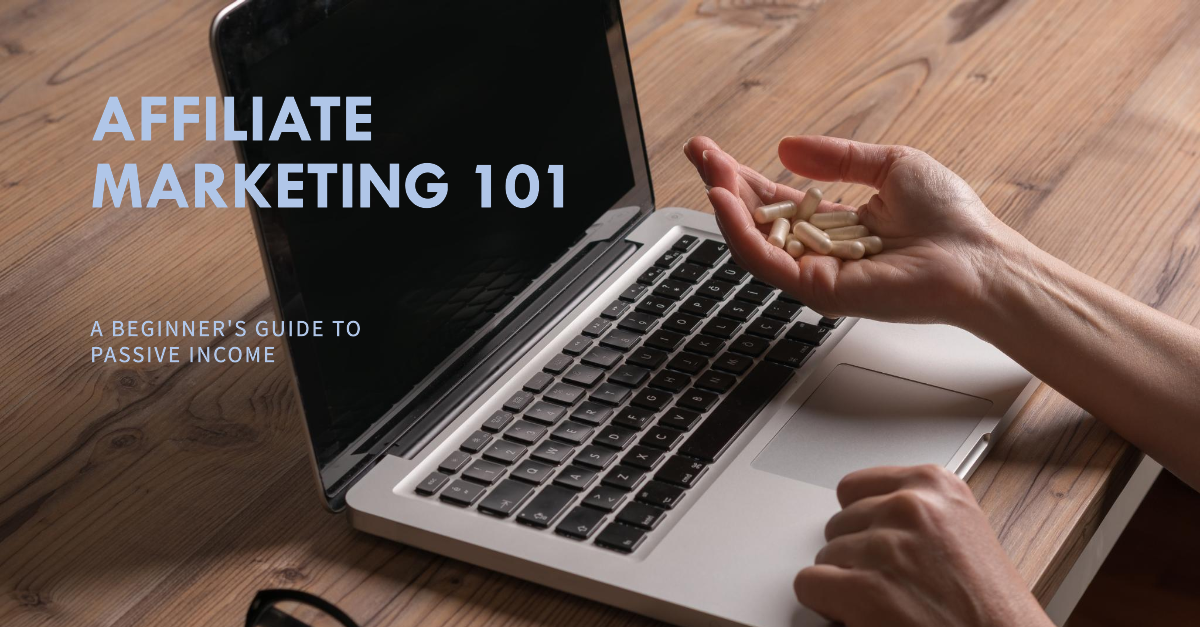In the modern era of digital entrepreneurship, making passive income has become a popular and attainable goal for many individuals. One of the most effective methods to achieve this is through affiliate marketing. This comprehensive guide, “Affiliate Marketing 101: A Beginner’s Guide to Making Passive Income,” aims to provide you with the essential knowledge and practical steps to start your affiliate marketing journey and create a sustainable income stream.
What is Affiliate Marketing?
Affiliate marketing is a performance-based marketing strategy where individuals, known as affiliates, earn a commission by promoting and selling products or services offered by another company. Affiliates use various marketing tactics to attract potential customers to the company’s products or services. When a customer purchases through the affiliate’s unique link, the affiliate earns a commission. This win-win model benefits both the company, which gains more sales, and the affiliate, which earns a commission for their marketing efforts.
How Does Affiliate Marketing Work?
To understand how affiliate marketing works, it’s essential to break down the process into key components:
- Merchant: The company or individual selling a product or service.
- Affiliate: The marketer who promotes the merchant’s product or service.
- Consumer: The potential customer who sees the affiliate’s marketing efforts and makes a purchase.
- Affiliate Network: An intermediary platform that connects affiliates with merchants and manages the tracking, reporting, and payment processes.
The process typically follows these steps:
- Sign Up: The affiliate joins an affiliate program offered by a merchant or through an affiliate network.
- Promote: The affiliate promotes the merchant’s products using various marketing channels such as blogs, social media, email marketing, and more.
- Track: The affiliate network tracks the clicks and sales generated through the affiliate’s unique referral link.
- Earn: When a consumer makes a purchase, the affiliate earns a commission, which is paid out by the affiliate network or the merchant.
Benefits of Affiliate Marketing. Affiliate Marketing 101
Affiliate marketing offers several benefits that make it an attractive option for beginners seeking to generate passive income:
1. Low Initial Investment
Starting an affiliate marketing business requires minimal upfront costs. Unlike traditional businesses that require significant capital for inventory, production, and other expenses, affiliate marketing allows you to promote existing products without substantial investments.
2. Flexibility and Convenience
Affiliate marketing can be done from anywhere, allowing you to work at your own pace and schedule. Whether you’re a stay-at-home parent, a student, or someone looking to supplement your income, affiliate marketing provides the flexibility to fit your lifestyle.
3. Diverse Income Streams
Affiliates can promote various products and services, creating multiple income streams. This diversification reduces the risk of relying on a single product or company and allows you to tap into various niches and markets.
4. Passive Income Potential
One of the most appealing aspects of affiliate marketing is the potential to earn passive income. Once you’ve set up your marketing campaigns and content, they can continue to generate sales and commissions without requiring constant effort.
5. Performance-Based Earnings
With affiliate marketing, your earnings are directly tied to your performance. The more effectively you promote products and drive sales, the higher your commissions will be. This incentivizes affiliates to improve their marketing strategies continually.
Getting Started with Affiliate Marketing: Affiliate Marketing 101
Now that you understand the basics and benefits of affiliate marketing let’s dive into the practical steps to get started:
Step 1: Choose Your Niche
Selecting a niche is a crucial first step in your affiliate marketing journey. A niche is a specific segment of the market that you’ll focus on. When choosing your niche, consider the following factors:
- Passion and Interest: Choose a niche you are passionate about and genuinely interested in. This will make it easier to create engaging content and stay motivated.
- Market Demand: Research the demand for products in your chosen niche. Use Google Trends, keyword research tools, and market analysis reports to gauge interest and potential profitability.
- Competition: Analyze the level of competition in your niche. While high competition can indicate a profitable market, it may also require more effort to stand out. Look for niches with moderate competition and room for growth.
Step 2: Join Affiliate Programs
Once you’ve chosen your niche, the next step is to join affiliate programs related to that niche. There are two main types of affiliate programs:
- Merchant Affiliate Programs: These are programs offered directly by companies selling products or services. Examples include Amazon Associates, Shopify Affiliate Program, and eBay Partner Network.
- Affiliate Networks: These are platforms that connect affiliates with multiple merchants. Examples include Commission Junction (CJ), ShareASale, Rakuten Marketing, and ClickBank.
When selecting affiliate programs, consider the following criteria:
- Commission Rates: Look for programs that offer competitive commission rates.
- Cookie Duration refers to when a cookie (tracking code) remains active on a potential customer’s browser. Longer cookie durations increase the chances of earning a commission.
- Product Quality: Promote products that are of high quality and relevant to your audience.
- Payment Terms: Review the payment terms and payout thresholds to ensure they align with your expectations.
Step 3: Build a Platform
To effectively promote affiliate products, you’ll need a platform to reach your target audience. The most common platforms for affiliate marketing include:
- Blog or Website: A blog or website is an excellent platform for creating content and promoting affiliate products. You can write product reviews, how-to guides, and other valuable content to attract visitors and drive sales.
- Social Media: Platforms like Instagram, Facebook, Twitter, and Pinterest can be used to share affiliate links and engage with your audience. Social media influencers often leverage their followers to promote products and earn commissions.
- Email Marketing: Building an email list lets you communicate directly with your audience and promote affiliate products. Offer valuable content, newsletters, and exclusive deals to engage subscribers.
- YouTube Channel: If you enjoy creating videos, a YouTube channel can be a powerful platform for affiliate marketing. Product reviews, tutorials, and unboxing videos can help you attract viewers and drive sales.
Step 4: Create High-Quality Content: Affiliate Marketing 101
Content is the cornerstone of successful affiliate marketing. High-quality content helps you build trust with your audience and encourages them to purchase through your affiliate links. Here are some tips for creating compelling content:
- Product Reviews: Write detailed and honest reviews of the products you are promoting. Highlight the features, benefits, and potential drawbacks to provide a balanced perspective.
- How-To Guides: Create informative guides that show your audience how to use the products effectively. Step-by-step instructions and tips can add value and drive conversions.
- Comparison Articles: Compare similar products to help your audience make informed decisions. Highlight the pros and cons of each product to guide their purchasing choices.
- Listicles: Create a list of articles that showcase the best products in a specific category. For example, “Top 10 Fitness Gadgets for 2024” can attract readers interested in fitness products.
- Engaging Visuals: Use high-quality images, infographics, and videos to make your content more appealing and shareable.
Step 5: Drive Traffic to Your Content
Creating great content is only half the battle. You need to drive traffic to your content to succeed in affiliate marketing. Here are some strategies to attract visitors to your platform:
- Search Engine Optimization (SEO): Optimize your content for search engines to increase organic traffic. Use relevant keywords, create compelling meta descriptions, and build backlinks to improve your search rankings.
- Social Media Marketing: Promote your content on social media platforms to reach a broader audience. Share engaging posts, join relevant groups, and interact with your followers to boost visibility.
- Email Marketing: Send regular newsletters and updates to your email subscribers. Include links to your latest content and special offers to drive traffic and conversions.
- Paid Advertising: Invest in paid advertising campaigns on platforms like Google Ads, Facebook Ads, and Instagram Ads. Target specific demographics and interests to reach potential customers.
- Guest Blogging: Write guest posts for other blogs and websites in your niche. Include links to your content to drive traffic and improve your authority.
Step 6: Monitor and Optimize Performance
Monitoring your performance and making data-driven decisions is essential to maximise your success in affiliate marketing. Use analytics tools to track key metrics such as:
- Clicks and Impressions: Monitor the number of clicks and impressions your affiliate links receive.
- Conversion Rate: Measure the percentage of visitors who purchase after clicking your affiliate link.
- Earnings and Commissions: Track your earnings and commissions to identify the most profitable products and strategies.
- Traffic Sources: Analyze where your traffic comes from to focus on the most effective channels.
Based on your data, optimize your content and marketing strategies to improve performance. Experiment with different types of content, promotional tactics, and affiliate programs to find what works best for your audience.
Common Mistakes to Avoid in Affiliate Marketing
While affiliate marketing offers great potential, it’s essential to avoid common pitfalls that can hinder your success:
1. Choosing the Wrong Niche
Selecting a niche solely based on profitability without considering your interests and expertise can lead to burnout and lacklustre content. Choose a niche that you are passionate about and knowledgeable in to maintain motivation and credibility.
2. Promoting Too Many Products
Promoting too many products can overwhelm your audience and dilute your efforts. Focus on a select few high-quality products that align with your niche and provide genuine value to your audience.
3. Ignoring the Audience
Your audience is your most valuable asset. Failing to understand their
needs, preferences, and pain points can result in irrelevant content and low engagement. Conduct thorough research and interact with your audience to create content that resonates with them.
4. Lack of Transparency
Transparency and honesty are crucial in affiliate marketing. Disclose your affiliate relationships to build trust with your audience. Avoid deceptive practices and provide honest reviews to maintain credibility.
5. Neglecting SEO
Ignoring SEO can limit your organic traffic potential. Invest time optimizing your content for search engines to increase visibility and attract more visitors. Conduct keyword research, create high-quality backlinks, and improve on-page SEO elements.
6. Failing to Track Performance
Without tracking and analyzing your performance, you won’t know what’s working and what’s not. Regularly monitor your metrics and make data-driven decisions to optimize your strategies and improve results.
Scaling Your Affiliate Marketing Business. Affiliate Marketing 101
Once you’ve gained some traction and experience in affiliate marketing, you can focus on scaling your business to increase your passive income:
1. Expand Your Content
Create more content to cover a broader range of topics within your niche. This will attract a larger audience and provide more opportunities for affiliate promotions. Consider adding new content formats such as videos, podcasts, and webinars.
2. Diversify Your Income Streams
To diversify your revenue, explore other income streams besides affiliate marketing. This can include creating and selling your products, offering consulting services, or joining additional affiliate programs in related niches.
3. Collaborate with Influencers
Partner with influencers in your niche to reach a wider audience. Influencers can promote your content and affiliate products to their followers, increasing your visibility and driving more sales.
4. Invest in Paid Advertising
As your business grows, allocate some of your earnings to paid advertising campaigns. Paid ads can help you reach new audiences, drive traffic, and boost conversions. Experiment with different ad platforms and targeting options to find the most effective strategies.
5. Build a Community
Foster a sense of community among your audience by creating forums, Facebook groups, or online communities. Engage with your followers, answer their questions, and provide valuable insights. A loyal and engaged community can significantly enhance your affiliate marketing efforts.
Conclusion
Affiliate marketing is a powerful and accessible way to generate passive income and achieve financial freedom. Following the steps outlined in this guide, “Affiliate Marketing 101: A Beginner’s Guide to Making Passive Income,” you can build a successful affiliate marketing business that provides long-term rewards. Remember to choose a niche you’re passionate about, create high-quality content, drive traffic to your platform, and continuously optimize your performance. With dedication and persistence, you can turn affiliate marketing into a sustainable source of passive income and enjoy the benefits of financial independence.
If you are looking for effective affiliate marketing 101 methods, click here to learn everything you need to know.
Some links in this article may be affiliate links, meaning they could generate compensation to us without any additional cost to you should you choose to purchase a paid plan. These are products we have personally used and confidently endorse. It’s important to note that this website does not offer financial advice. You can review our affiliate disclosure in our privacy policy for more information.




